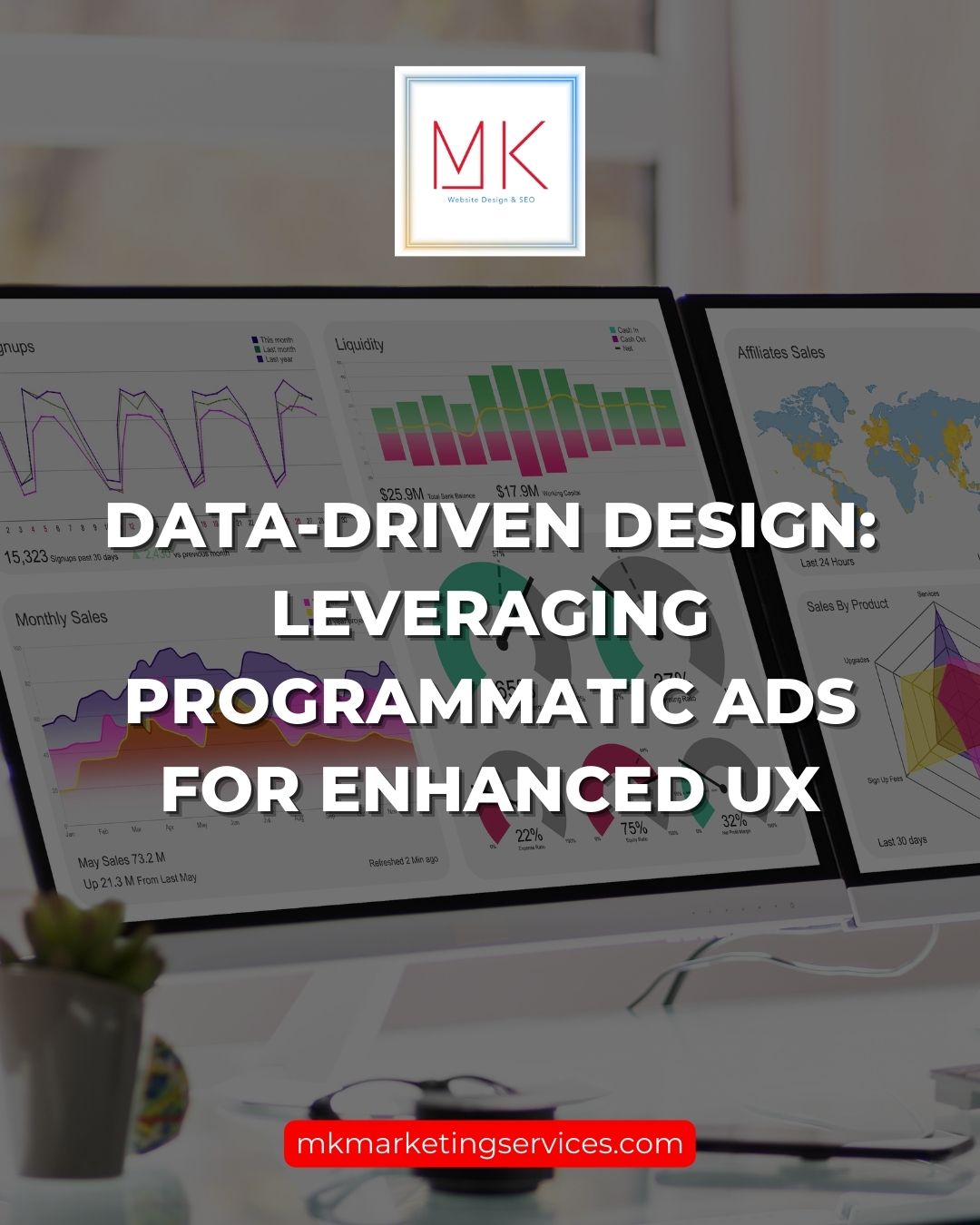The digital era has brought forth two monumental changes to the fields of design and advertising: data-driven design and programmatic advertising. These innovative approaches utilize vast amounts of information to tailor digital experiences and promotions, fostering user engagement, personalization, and ultimately, conversion.
Let’s dive deep into the exciting worlds of data-driven design and programmatic advertising, exploring how they’re reshaping the way we think about user experiences (UX).
Understanding Data-Driven Design
Data-driven design is a design philosophy that places data at the heart of the creative process. It involves using quantitative and qualitative data collected from users to guide design decisions, making it a powerful tool for creating experiences that meet user needs and preferences.
The beauty of data-driven design lies in its efficacy and precision. Data can highlight pain points, reveal user behavior patterns, and unveil opportunities for improvement. Examples of data used in this approach may include user demographics, behavior metrics, and user feedback.
Despite these benefits, challenges exist. Collecting relevant data can be time-consuming and demanding, requiring careful planning and execution. Balancing data-driven inputs with creative intuition is another key challenge.
Addressing Challenges in Data-Driven Design
When it comes to tackling the challenges that come with data-driven design, a diverse approach is key. Using strong analytics tools, digging into user research, and applying data sampling techniques, gathering relevant data becomes a more manageable task.
To marry data insights with creativity, embrace a design process that keeps the user front and center, encourages collaboration in decision-making, and involves a cycle of prototyping and testing.
Designers can make the most of the collected data by honing their data analysis skills, utilizing visuals to better comprehend the data, and adopting an iterative design process. When these strategies are put into practice, they can help organizations navigate these hurdles and craft products and services that deliver a top-notch, customized user experience.
The Mechanics of Programmatic Advertising
Programmatic advertising refers to the automated buying and selling of online ad spaces through sophisticated algorithms. This data-oriented advertising model allows businesses to deliver personalized ads to specific audience segments at the right time, in the right context.
One of the major advantages of programmatic advertising is its ability to target ads with precision, thus improving ad relevance and performance. It relies heavily on data and machine learning algorithms to optimize campaigns in real-time.
Companies like Airbnb and Uber have significantly benefited from programmatic advertising. They were able to target their audience with tailored messages across multiple platforms, thus enhancing their brand visibility and conversion rates.
Integrating Programmatic Advertising into Data-Driven Design
Programmatic advertising and data-driven design are complementary, with both relying heavily on data for decision-making. The former provides valuable user data that can help UX/UI designers to understand user behavior better and tailor their designs accordingly.
Consider this scenario: a programmatic ad campaign for a music streaming service reveals that a substantial portion of users in the 18-24 age demographic shows strong interest in indie rock music. They often engage with ads promoting indie rock playlists or concerts.
This data, while initially used to improve ad targeting, could also feed into the streaming service’s data-driven design process. Armed with this knowledge, the UX/UI design team can alter the platform to showcase more indie rock content on the homepage for users in this age range, enhancing the personalization of their user experience.
This change, informed by data from programmatic advertising, could increase user engagement and satisfaction, as users feel understood and catered to by the platform.
Creating a Cycle of Continuous Improvement
This example illustrates the interplay between programmatic advertising and data-driven design. Both function harmoniously, each reinforcing the other, to create a feedback loop of continuous improvement.
The data gathered from programmatic ads fuels the design process, and the improved design, in turn, enhances user engagement and thus the effectiveness of future ads.
It’s a cycle of enhancement that benefits all involved: the user, the advertiser, and the design team.
This approach allows businesses to provide digital experiences that are not just intuitive and visually appealing, but also deeply aligned with users’ needs and preferences, thereby significantly enhancing the overall user experience.
Practical Guidelines for Implementation
Successfully implementing programmatic advertising into your UX design process requires strategic planning and an in-depth understanding of both domains.
Here are some actionable steps you can take to leverage these strategies effectively:
1. Establish Clear Objectives and KPIs
Before you embark on integrating programmatic advertising and data-driven design, it’s important to have a clear understanding of what you’re hoping to achieve.
Defining your goals and identifying key performance indicators (KPIs) will provide a roadmap for your efforts. Are you aiming to boost user engagement, increase conversions, or improve overall user satisfaction? Each goal might require different strategies and tools.
Pro Tip: Make your goals SMART – Specific, Measurable, Achievable, Relevant, and Time-bound. This makes tracking progress and achieving success more manageable.
Tools: Use project management tools like Trello or Asana to help set and track these objectives and KPIs.
2. Collect Relevant Data
An essential step in this process is collecting pertinent user data. This can be achieved through various analytics tools that track user behavior on your platform. Gather data about user demographics, interaction patterns, and preferences.
The more granular the data, the better you’ll understand your users and be able to tailor your design and advertisements accordingly.
Pro Tip: Don’t just collect data for the sake of it. Ensure you are gathering actionable data points that can inform your design decisions and ad targeting.
Tools: Google Analytics is a powerful tool for collecting and analyzing user data. For in-app behavior, tools like Mixpanel or Amplitude are useful.
3. Choose the Right Programmatic Advertising Technology
To run successful programmatic ad campaigns, it’s important to choose the right technology. Demand Side Platforms (DSPs) are often the go-to choice for managing programmatic advertising due to their ability to handle real-time bidding and advanced audience targeting.
When selecting a DSP, look for features such as a wide range of inventory access, advanced targeting options, easy-to-use interface, and strong data management and analytics capabilities.
Pro Tip: When choosing a DSP, consider not just its features but also its integration capabilities with your existing systems and whether it complies with data privacy regulations.
Tools: Platforms like MediaMath, Google’s Display & Video 360, or The Trade Desk offer robust DSP capabilities.
3. Integration of Data-Driven Design and Programmatic Ads
Once you have your data and technology in place, start integrating programmatic advertising insights into your design process. Use the data gleaned from ad campaigns to influence design decisions.
For example, if you notice that users who interact with a certain type of ad also tend to use specific features of your platform, consider making those features more prominent in your design.
Pro Tip: Foster a close collaboration between your design team and the team handling programmatic advertising. This can ensure a seamless transfer and application of insights.
Tools: Collaboration tools such as Slack or Microsoft Teams can be helpful for facilitating communication between these teams.
4. Start Small and Iterate
Begin by integrating programmatic advertising and data-driven design on a small scale, perhaps on a specific product feature or a particular user journey.
This way, you can learn from these experiments and iterate on your approach.
Pro Tip: A/B testing is your friend here. Compare the performance of different designs and use the insights to continuously improve.
Tools: Platforms like Optimizely or Google Optimize can help you run A/B testing smoothly.
4. Continuous Improvement
Remember that enhancing UX is a continuous process. Monitor your KPIs closely, and be ready to make necessary adjustments based on your observations. Over time, you’ll refine your approach, improve your user understanding, and consequently enhance the overall UX.
Pro Tip: Regularly revisit your goals and KPIs, and be flexible about adjusting your strategies based on what the data is telling you.
Tools: Data visualization tools like Tableau or Looker can help you monitor KPIs and spot trends or areas needing improvement over time.
Remember, the successful integration of programmatic advertising and data-driven design doesn’t happen overnight. It’s a process of constant learning and refinement.
With these pro tips and tools, you can move closer to delivering a user experience that is deeply personalized, engaging, and ultimately drives your business objectives.
Conclusion
As we step further into the era of data-driven decision-making, the importance of user-centric design and targeted advertising only continues to grow. To leverage these strategies effectively, clear goals, the right technology, relevant data, and an iterative mindset are key. It’s an ongoing journey of learning and refining, but one that holds great promise for both businesses and users alike.
So, whether you’re a digital marketer, a UX/UI designer, a product manager, or a business owner, we encourage you to explore the dynamic interplay between programmatic advertising and data-driven design in your projects. Harness the power of data and technology to create digital experiences that truly resonate with your users. The potential for enhancement in user experience is immense, and the journey towards it is an exciting one.
AUTHOR:
Farlyn Lucas is a freelance writer specializing in business and marketing. She has worked with various clients, mostly early startups and SMBs. When she’s not writing, Farlyn enjoys spending time in nature and reading up on the latest trends and practices in sustainable business.













